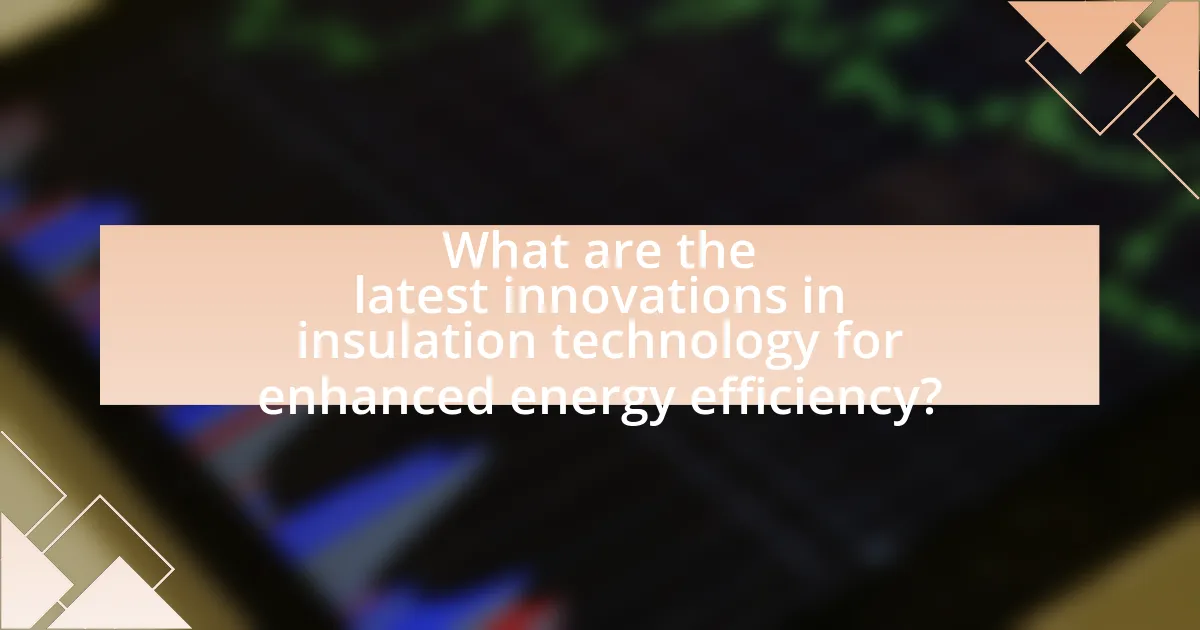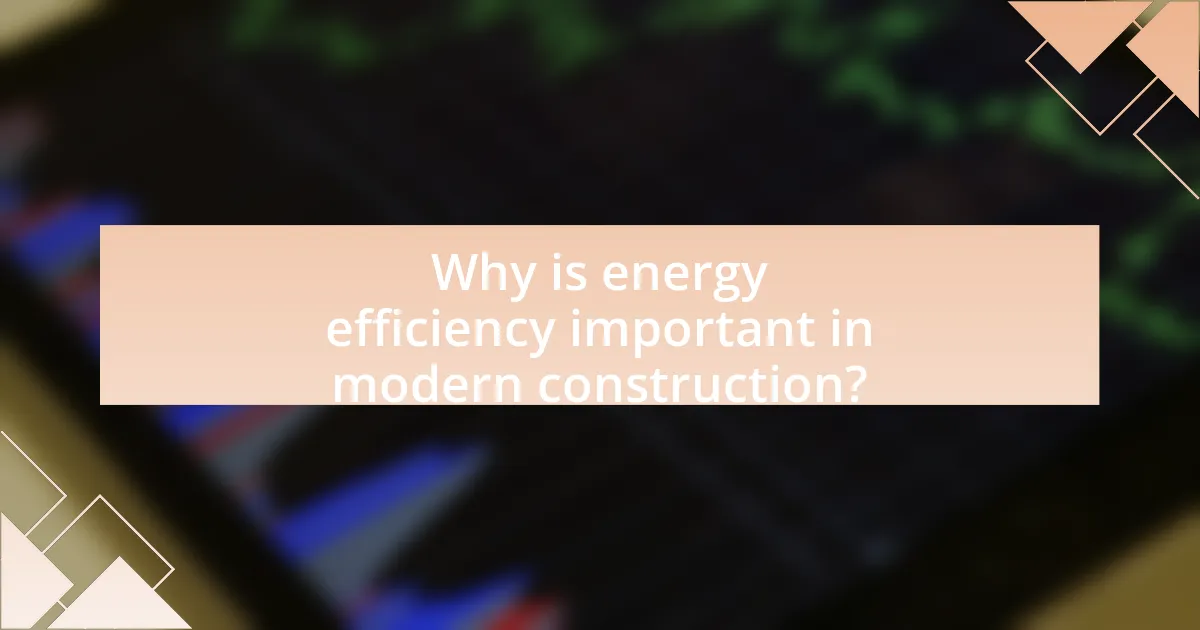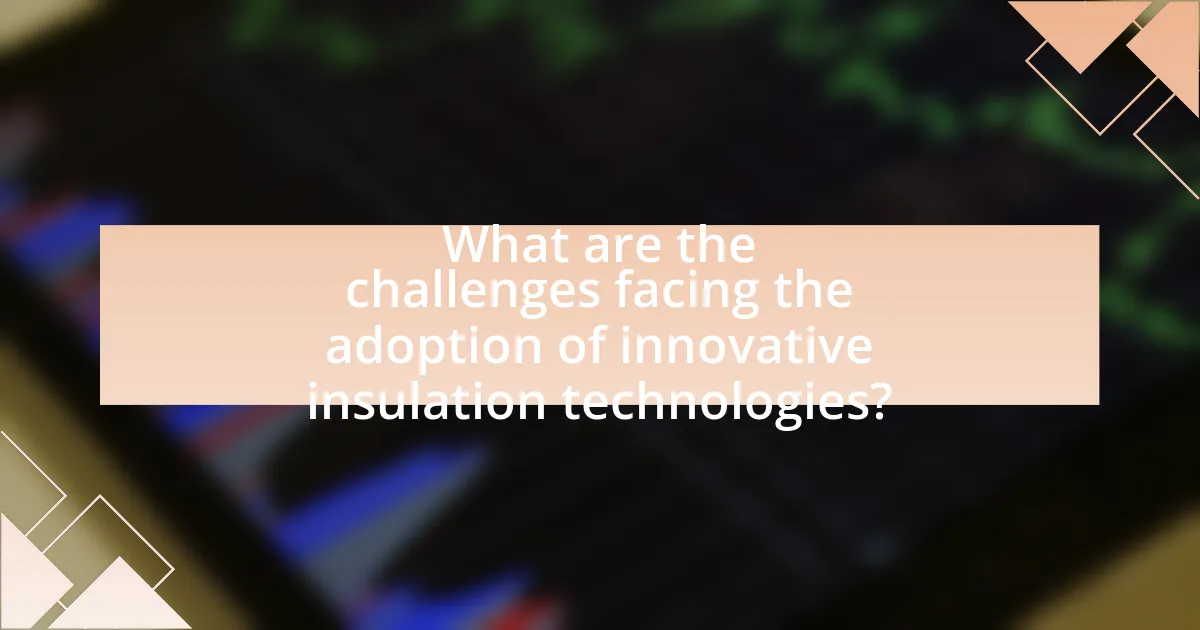The article focuses on innovations in insulation technology aimed at enhancing energy efficiency in buildings. It highlights advanced materials such as vacuum insulation panels (VIPs), aerogel insulation, and phase change materials (PCMs), which significantly outperform traditional insulation options in thermal resistance and energy savings. The discussion includes the role of technology in improving insulation methods, the impact of energy-efficient practices on environmental sustainability, and the challenges and incentives associated with adopting these innovative solutions. Additionally, it addresses best practices for selecting insulation materials and assessing their effectiveness, providing a comprehensive overview of the current landscape in insulation technology.

What are the latest innovations in insulation technology for enhanced energy efficiency?
The latest innovations in insulation technology for enhanced energy efficiency include vacuum insulation panels (VIPs), aerogel insulation, and phase change materials (PCMs). VIPs provide superior thermal resistance with a thickness significantly less than traditional insulation, making them ideal for space-constrained applications. Aerogel insulation, known for its lightweight and high thermal performance, can achieve R-values exceeding 10 per inch, which is substantially higher than conventional materials. PCMs enhance energy efficiency by absorbing and releasing thermal energy, thus stabilizing indoor temperatures and reducing heating and cooling demands. These advancements are supported by research indicating that VIPs can reduce energy loss by up to 50%, while aerogels can improve energy efficiency in buildings by 30% compared to standard insulation methods.
How do these innovations improve energy efficiency in buildings?
Innovations in insulation technology improve energy efficiency in buildings by reducing heat transfer, thereby minimizing energy consumption for heating and cooling. Advanced materials, such as aerogels and vacuum insulation panels, offer superior thermal resistance compared to traditional insulation, leading to lower energy costs. For instance, studies have shown that buildings utilizing these advanced insulation materials can achieve energy savings of up to 50% compared to those with conventional insulation. Additionally, smart insulation systems that adapt to environmental conditions further enhance energy efficiency by optimizing thermal performance in real-time.
What specific materials are being developed for better insulation?
Aerogel, vacuum insulation panels, and phase change materials are specific materials being developed for better insulation. Aerogel is known for its extremely low thermal conductivity, making it one of the best insulating materials available. Vacuum insulation panels provide superior insulation by minimizing heat transfer through a vacuum layer, achieving R-values significantly higher than traditional insulation. Phase change materials enhance energy efficiency by absorbing and releasing thermal energy, thus maintaining stable temperatures in buildings. These materials are being researched and implemented to improve energy efficiency in construction and reduce heating and cooling costs.
How do these materials compare to traditional insulation options?
Innovative insulation materials often outperform traditional options in energy efficiency, thermal performance, and environmental impact. For instance, materials like spray foam and aerogel provide superior R-values, which measure thermal resistance, compared to fiberglass or cellulose. Spray foam can achieve R-values of 6 to 7 per inch, while traditional fiberglass typically offers R-values around 2.9 to 4.3 per inch. Additionally, many modern materials are designed to be more environmentally friendly, with lower embodied energy and reduced greenhouse gas emissions during production, unlike conventional insulation that may contain harmful chemicals. This combination of enhanced performance and sustainability makes innovative insulation materials a more effective choice than traditional options.
What role does technology play in advancing insulation methods?
Technology plays a crucial role in advancing insulation methods by enabling the development of more efficient materials and installation techniques. Innovations such as aerogel, which has a thermal conductivity as low as 0.013 W/m·K, significantly improve insulation performance compared to traditional materials. Additionally, advancements in manufacturing processes, like the use of nanotechnology, enhance the properties of insulation materials, making them lighter and more effective. Furthermore, smart insulation systems that integrate sensors and automation allow for real-time monitoring and optimization of energy efficiency in buildings, demonstrating the transformative impact of technology on insulation methods.
How are smart technologies integrated into insulation solutions?
Smart technologies are integrated into insulation solutions through the use of advanced materials, sensors, and automation systems that enhance energy efficiency. These technologies enable real-time monitoring of temperature and humidity levels, allowing for adaptive insulation performance that responds to environmental changes. For instance, smart insulation materials can adjust their thermal resistance based on external conditions, optimizing energy use in buildings. Additionally, systems like smart thermostats and building management software can analyze data from insulation sensors to improve heating and cooling efficiency, leading to reduced energy consumption and lower utility costs.
What are the benefits of using advanced manufacturing techniques in insulation production?
Advanced manufacturing techniques in insulation production enhance efficiency, reduce costs, and improve product performance. These techniques, such as automation and additive manufacturing, streamline the production process, leading to faster turnaround times and lower labor costs. For instance, the use of computer-aided design (CAD) allows for precise customization of insulation materials, resulting in better thermal performance and reduced waste. Additionally, advanced techniques enable the integration of smart materials that can adapt to environmental changes, further increasing energy efficiency. According to a study by the Department of Energy, implementing advanced manufacturing processes can reduce energy consumption in production by up to 30%, demonstrating significant benefits in both economic and environmental aspects.

Why is energy efficiency important in modern construction?
Energy efficiency is crucial in modern construction because it significantly reduces energy consumption and operational costs while minimizing environmental impact. Buildings account for approximately 40% of global energy use, and improving energy efficiency can lead to a reduction in greenhouse gas emissions. For instance, the U.S. Department of Energy reports that energy-efficient buildings can reduce energy use by 30-50%, which not only lowers utility bills but also enhances occupant comfort and health. Furthermore, energy-efficient construction practices contribute to sustainable development goals by promoting resource conservation and reducing reliance on fossil fuels.
How does energy efficiency impact environmental sustainability?
Energy efficiency significantly enhances environmental sustainability by reducing energy consumption and minimizing greenhouse gas emissions. When buildings and systems utilize energy more effectively, they require less energy from fossil fuels, which are major contributors to climate change. For instance, according to the U.S. Department of Energy, improving energy efficiency in buildings can reduce energy use by up to 30%, leading to a substantial decrease in carbon dioxide emissions. This reduction not only helps mitigate global warming but also conserves natural resources, promoting a healthier ecosystem.
What are the long-term benefits of energy-efficient buildings?
Energy-efficient buildings provide significant long-term benefits, including reduced energy costs, improved indoor air quality, and increased property value. Over time, these structures can lower energy consumption by up to 30-50%, leading to substantial savings on utility bills. Additionally, energy-efficient designs often incorporate better ventilation and materials that enhance indoor air quality, which can contribute to better health outcomes for occupants. Furthermore, properties that prioritize energy efficiency typically see an increase in market value; studies indicate that energy-efficient homes can sell for 3-5% more than their less efficient counterparts. These benefits collectively contribute to a more sustainable environment and economic savings for both owners and tenants.
How do energy-efficient practices contribute to cost savings for homeowners?
Energy-efficient practices contribute to cost savings for homeowners by reducing energy consumption and lowering utility bills. For instance, implementing advanced insulation technologies can decrease heating and cooling costs by up to 30%, as reported by the U.S. Department of Energy. Additionally, energy-efficient appliances and systems often qualify for rebates and tax incentives, further enhancing financial savings. These practices not only lead to immediate reductions in energy expenses but also increase the overall value of the home, making them a financially sound investment.
What regulations and standards are influencing insulation technology?
Regulations and standards influencing insulation technology include the International Energy Conservation Code (IECC), which sets minimum energy efficiency requirements for buildings, and the ASHRAE 90.1 standard, which provides guidelines for energy-efficient design. These regulations aim to reduce energy consumption and greenhouse gas emissions, promoting the use of advanced insulation materials and techniques. For instance, the IECC mandates specific R-values for insulation in different climate zones, ensuring that buildings maintain energy efficiency. Compliance with these standards is essential for manufacturers and builders to meet legal requirements and achieve energy efficiency certifications.
How do building codes affect the adoption of new insulation technologies?
Building codes significantly influence the adoption of new insulation technologies by establishing minimum performance standards that must be met for compliance. These regulations often dictate the types of materials and methods that can be used in construction, which can either facilitate or hinder the integration of innovative insulation solutions. For instance, codes that prioritize energy efficiency may encourage the use of advanced insulation materials, such as spray foam or aerogel, which offer superior thermal performance compared to traditional options. Conversely, stringent codes that favor established materials may slow the adoption of newer technologies, as builders may be reluctant to invest in unproven solutions that do not yet meet regulatory requirements. This dynamic is evident in regions that have adopted updated energy codes, leading to increased market penetration of high-performance insulation technologies, as seen in the 2018 International Energy Conservation Code, which promotes enhanced insulation standards.
What incentives exist for using energy-efficient insulation solutions?
Incentives for using energy-efficient insulation solutions include tax credits, rebates, and lower energy bills. Tax credits, such as those offered under the Energy Policy Act, can provide significant financial relief for homeowners who invest in qualifying insulation materials. Additionally, many utility companies offer rebates for energy-efficient upgrades, which can further reduce upfront costs. Furthermore, energy-efficient insulation leads to lower heating and cooling costs, with studies indicating that proper insulation can reduce energy bills by 20% to 30%. These financial benefits encourage the adoption of energy-efficient insulation solutions, promoting both economic savings and environmental sustainability.

What are the challenges facing the adoption of innovative insulation technologies?
The challenges facing the adoption of innovative insulation technologies include high initial costs, lack of awareness, regulatory barriers, and performance uncertainties. High initial costs deter many consumers and builders from investing in advanced insulation materials, as they often require a significant upfront investment compared to traditional options. Lack of awareness about the benefits and availability of these technologies limits their market penetration, as potential users may not understand their energy-saving potential. Regulatory barriers, such as building codes and standards that favor conventional materials, can hinder the integration of innovative solutions into construction practices. Additionally, performance uncertainties regarding the long-term effectiveness and durability of new insulation technologies can create hesitation among stakeholders, as they seek proven solutions that guarantee energy efficiency and cost savings over time.
How do cost factors influence the implementation of new insulation methods?
Cost factors significantly influence the implementation of new insulation methods by determining the financial feasibility and return on investment for both manufacturers and consumers. High initial costs can deter adoption, as stakeholders often weigh the long-term energy savings against upfront expenses. For instance, advanced insulation materials like aerogel may offer superior thermal performance but come with higher production costs, which can limit their market penetration. Additionally, economic incentives, such as government subsidies or tax credits for energy-efficient upgrades, can mitigate these costs, encouraging broader implementation. Studies indicate that insulation retrofits can yield energy savings of 20-30%, making cost considerations crucial in decision-making processes for both residential and commercial applications.
What are the barriers to entry for manufacturers of innovative insulation products?
Manufacturers of innovative insulation products face several barriers to entry, including high research and development costs, stringent regulatory requirements, and established competition. High research and development costs are necessary to create effective and compliant insulation materials, which can deter new entrants lacking sufficient capital. Stringent regulatory requirements, such as safety and environmental standards, necessitate compliance that can be complex and costly, further complicating market entry. Established competition from existing manufacturers with brand loyalty and economies of scale creates additional challenges, as new entrants must differentiate their products and establish market presence. These factors collectively hinder the ability of new manufacturers to successfully enter the insulation market.
How can education and awareness improve the adoption of energy-efficient insulation?
Education and awareness can significantly improve the adoption of energy-efficient insulation by informing consumers about its benefits and cost savings. When individuals understand that energy-efficient insulation can reduce energy bills by up to 30% and enhance comfort in their homes, they are more likely to invest in it. Studies show that informed homeowners are 50% more likely to choose energy-efficient options when they are aware of the long-term savings and environmental impact. Additionally, educational programs can provide information on available incentives and rebates, further motivating adoption.
What practical steps can homeowners take to enhance energy efficiency through insulation?
Homeowners can enhance energy efficiency through insulation by sealing air leaks, adding insulation to attics and walls, and using energy-efficient materials. Sealing air leaks around windows, doors, and ducts can reduce energy loss by up to 30%, according to the U.S. Department of Energy. Adding insulation in attics can improve energy efficiency by maintaining temperature, with recommended R-values varying by climate zone. Utilizing advanced materials like spray foam or cellulose can further increase insulation effectiveness, as these materials provide better thermal resistance and air sealing properties.
What are the best practices for selecting insulation materials for energy efficiency?
The best practices for selecting insulation materials for energy efficiency include evaluating the R-value, considering the material’s environmental impact, and assessing moisture resistance. The R-value measures thermal resistance, with higher values indicating better insulation performance; for example, fiberglass insulation typically has an R-value between 2.9 and 4.3 per inch, making it a popular choice. Additionally, selecting materials with low embodied energy, such as cellulose or sheep’s wool, can reduce the overall environmental footprint. Moisture resistance is crucial to prevent mold growth and degradation of insulation performance; materials like closed-cell spray foam offer superior moisture barriers. These practices ensure optimal energy efficiency and long-term sustainability in insulation choices.
How can homeowners assess the effectiveness of their current insulation?
Homeowners can assess the effectiveness of their current insulation by conducting a thermal imaging inspection, which identifies areas of heat loss or gain. This method utilizes infrared cameras to visualize temperature differences, revealing insulation deficiencies. Studies indicate that homes with proper insulation can reduce energy costs by up to 30%, highlighting the importance of effective insulation. Additionally, homeowners can perform a simple check by feeling for drafts around windows and doors, which indicates inadequate insulation. Regular assessments ensure that insulation meets current energy efficiency standards, ultimately contributing to lower utility bills and improved comfort.